Sculpting History in Stone: The Finest Ancient Marble Statues

Welcome to a captivating journey through time and artistry, as we unveil the mesmerizing world of "Sculpting History in Stone: The Finest Ancient Marble Statues." Delve into the depths of antiquity and discover the extraordinary craftsmanship and profound cultural significance embodied in ancient marble sculptures.
These masterpieces encapsulated the essence of their respective societies, reflecting their beliefs, ideologies, and societal values. In this exploration, we will traverse the annals of time, visiting renowned ancient marble statues that have left an indelible mark on art and culture. Join us as we unravel the artistry, symbolism, and historical significance of these exquisite creations, and appreciate how the finest ancient marble statues continue to resonate with us, bridging the gap between the past and our present appreciation of art.
David By Michelangelo
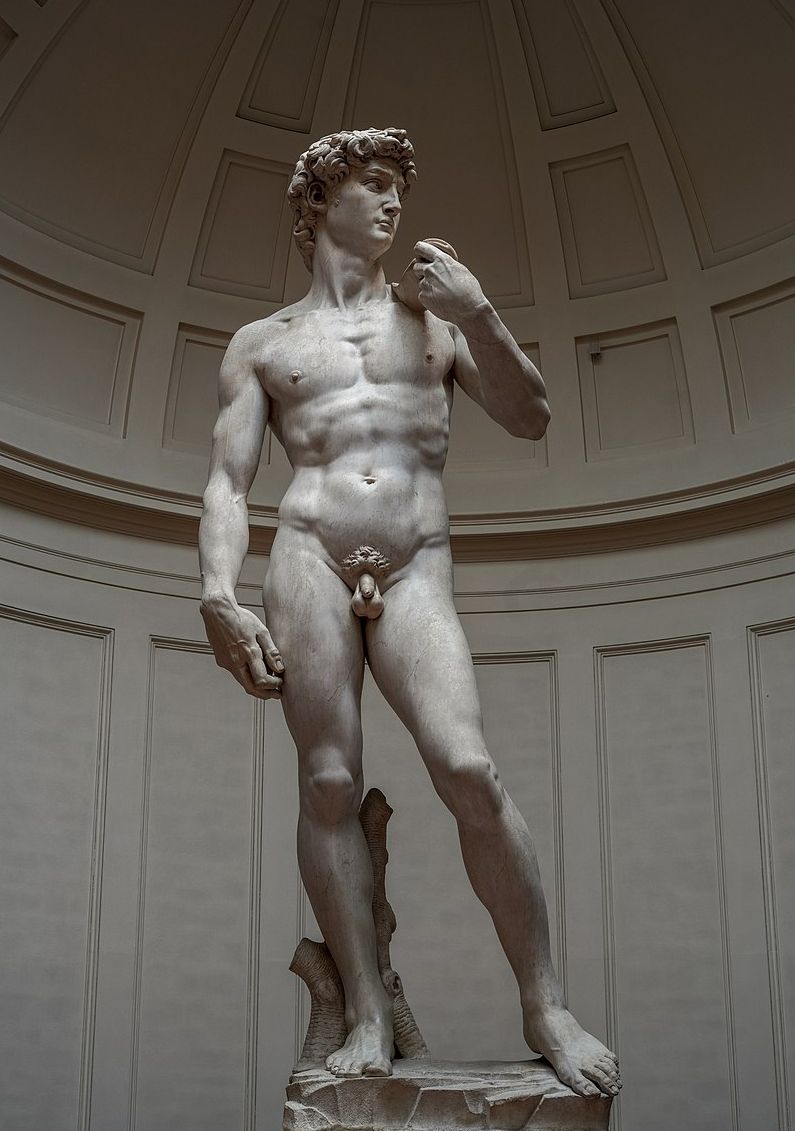
"David" by Michelangelo, a marvel of Renaissance sculpture, stands as a beacon of artistic genius and human potential. Crafted from a single block of Carrara marble, this masterpiece embodies the perfect fusion of raw material and meticulous craftsmanship.
Michelangelo's David portrays the biblical hero poised in contemplation before facing the mighty Goliath. The sculpture exudes an extraordinary level of detail, showcasing the intricate musculature and anatomy, a testament to Michelangelo's unparalleled skill. David's expression captures a blend of determination, concentration, and quiet resolve, epitomizing the triumph of intellect and courage over brute force.
Measuring over 17 feet in height, this statue stands as a symbol of Florence's proud independence during the Renaissance. Beyond its artistic brilliance, David signifies the Renaissance ideals of humanism and the belief in the potential of human achievement. Today, it remains an icon of Renaissance artistry, drawing admirers from across the globe to witness its timeless elegance and the enduring spirit of human accomplishment.
Pietà By Michelangelo

"Pietà," a masterpiece sculpted by Michelangelo, exemplifies profound emotion and divine grace in marble. Crafted during the early 16th century, this iconic sculpture depicts the Virgin Mary cradling the lifeless body of Jesus Christ after his crucifixion.
Michelangelo's brilliance lies in the seamless blend of delicacy and strength in the figures, showcasing Mary's youthful form and Christ's lifeless repose. The smooth marble seems to flow like fabric, lending a sense of ethereal softness to the composition. The intense sorrow on Mary's face is juxtaposed with the serene acceptance of Christ's fate, reflecting the human experience of grief and divine purpose.
The Pietà not only showcases Michelangelo's unparalleled technical skill but also his ability to convey deep spiritual and emotional themes through stone. It remains an enduring symbol of Christian faith, inviting contemplation on sacrifice, redemption, and the beauty of compassion. As visitors stand before this work, they are moved by its solemn beauty and the timeless representation of a mother's love and the sacrifice of her son for humanity.
The Greek Slave

"The Greek Slave," a captivating marble sculpture by Hiram Powers, epitomizes neoclassical artistry and cultural commentary. Created in the mid-19th century, Powers' sculpture illustrates the plight of a Greek woman taken captive during the Greek War of Independence.
The statue portrays a young woman, captured and enslaved, standing in a vulnerable yet dignified pose. Her chains symbolize her captivity, serving as a powerful metaphor for the oppression faced by the Greeks during their struggle for freedom. Despite her circumstances, she maintains a sense of inner strength and resilience.
Powers' meticulous attention to detail, particularly in capturing the intricacies of the drapery and the woman's expressive face, adds to the poignancy of the piece. "The Greek Slave" not only showcases artistic brilliance but also carries a deep social and political message, urging viewers to reflect on the atrocities of war and the resilience of the human spirit in the face of adversity. It stands as a reminder of the enduring quest for freedom and human rights across cultures and eras.
The Colossal Statue Of Augustus
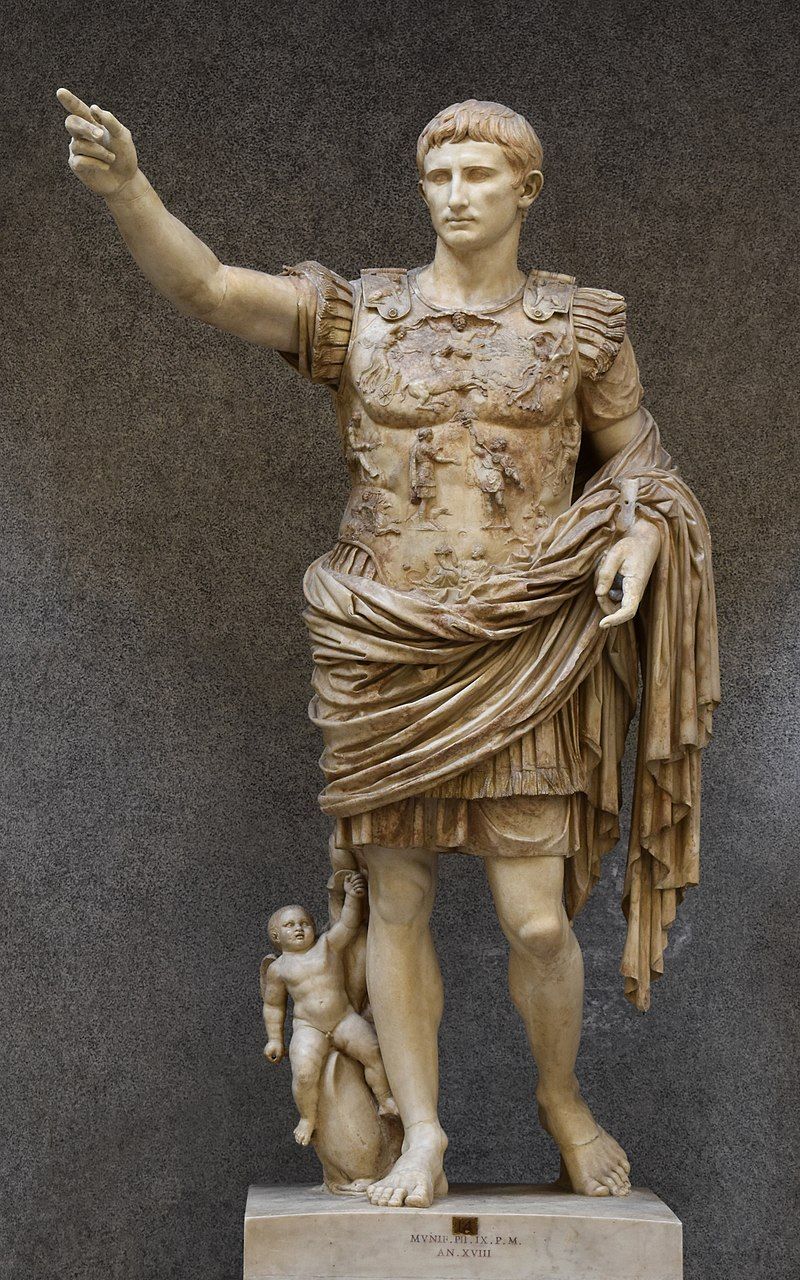
The Colossal Statue of Augustus, a remarkable marble sculpture, embodies the grandeur and authority of Augustus Caesar, the first Roman Emperor. Created during the early 1st century CE, this immense statue stood as a symbol of imperial power and divine status.
Measuring over 12 meters in height, this statue portrayed Augustus in a heroic, idealized form, clad in military garb. The meticulously sculpted details, from the intricacies of the armor to the resolute expression on his face, conveyed strength and authority. It was strategically placed in public spaces, serving as a potent propaganda tool, reinforcing Augustus's dominion over the Roman Empire and his role as a revered statesman and military leader.
The Colossal Statue of Augustus is a testament to the artistic prowess of ancient Roman sculptors and their ability to capture the essence of power and prestige in stone. Despite its fragments today, the legacy of this colossal marvel continues to echo the might and influence of Augustus's reign in the annals of history.
Statue of Hercules, reassembled from 112 pieces
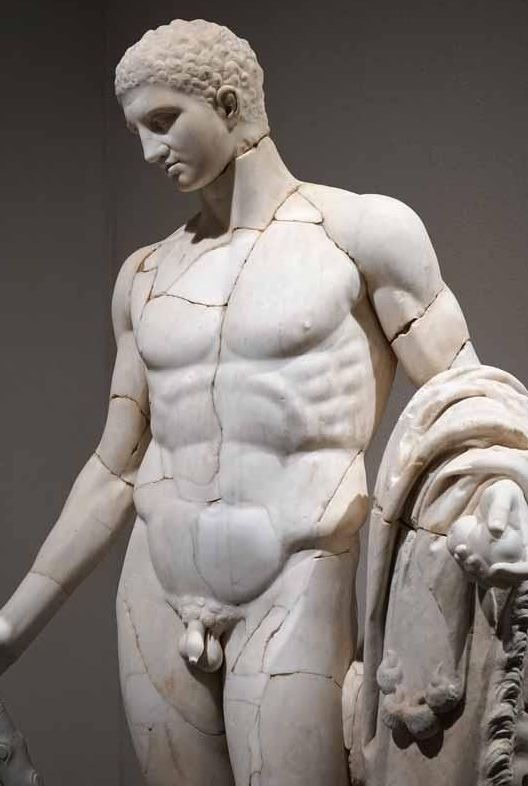
The Statue of Hercules, an awe-inspiring marble sculpture, has been meticulously reassembled from 112 fragmented pieces, revealing the might and glory of this legendary figure. Dating back to antiquity, this statue depicts Hercules, the hero of Greek mythology renowned for his immense strength and valor.
Through a painstaking restoration process, the scattered remnants have been skillfully pieced together, showcasing Hercules in his dynamic pose, a symbol of triumph over adversity. The meticulous reassembly allows us to witness the intricate details of his musculature and the determination in his countenance.
The fragmented nature of the statue is a metaphor for the passage of time and the resilience of the human spirit. It speaks to the endurance of ancient craftsmanship and the enduring fascination with myth and heroism. As we gaze upon the reassembled Statue of Hercules, we are transported to a time of myth and legend, where strength and perseverance were celebrated, and where the echoes of this heroic tale resonate through the ages.
Nike of Samothrace
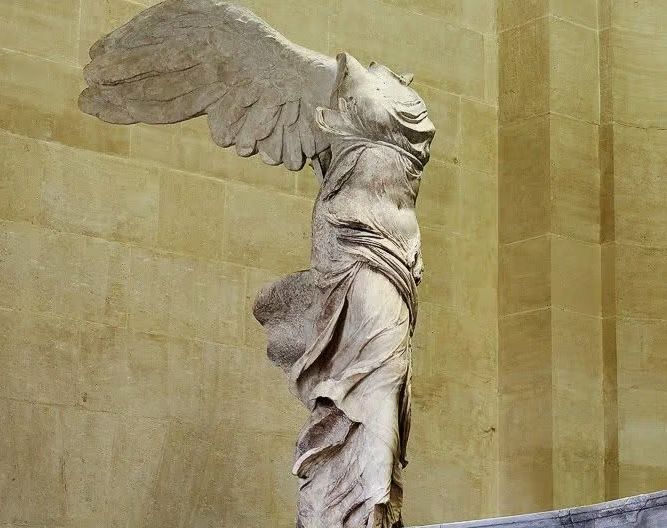
The Nike of Samothrace, also known as the Winged Victory of Samothrace, stands as a timeless testament to ancient Greek artistry and symbolism. This extraordinary marble sculpture was crafted during the Hellenistic period, around the 2nd century BCE, on the island of Samothrace in Greece.
The sculpture embodies Nike, the Greek goddess of victory, depicted in a dynamic pose with her wings unfurled, standing atop a ship's prow. This iconic composition evokes a sense of triumph and elation, capturing the goddess in mid-flight, cascading wind-blown drapery, and an exultant spirit.
Discovered in 1863 on the island of Samothrace, missing only its head and arms, the statue has been meticulously restored to convey its original splendor. The Nike of Samothrace is celebrated for its breathtaking artistry, showcasing mastery over form and movement, making it a symbol of victory, freedom, and the epitome of classical Greek sculpture.
Its presence in the Louvre Museum in Paris allows visitors to marvel at its grace and artistry, offering a glimpse into the rich history and cultural significance of ancient Greece.
The Persian Warrior
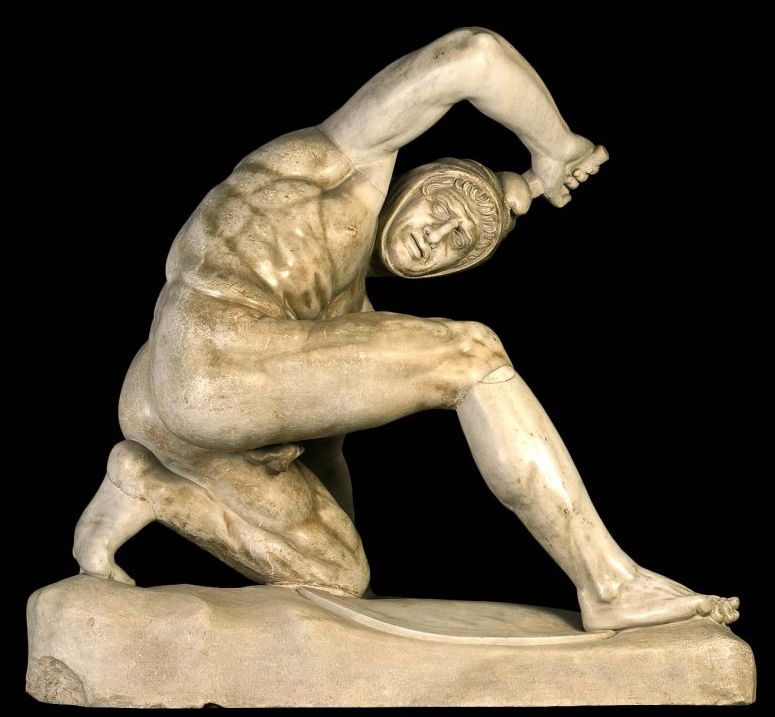
The Persian Warrior, an evocative depiction sculpted in marble, echoes the valor and martial prowess of ancient Persia. This sculpture hails from an era when the Persian Empire held vast influence over a significant portion of the known world, showcasing the military might and courage that characterized their warriors.
Captured in stone, the Persian Warrior embodies strength, discipline, and the stoic determination characteristic of ancient Persian soldiers. The attention to detail, from the intricacies of armor to the facial expressions conveying both focus and resolve, provides a vivid glimpse into the martial culture of that era.
The sculpture serves as a poignant reminder of the historical struggles and triumphs of the Persian Empire, inviting contemplation on the intricate relationship between art, history, and the human spirit. As we admire the Persian Warrior, we honor the legacy of a civilization that left an indelible mark on the annals of history, both through their military exploits and enduring artistic achievements.
Apollo Belvedere
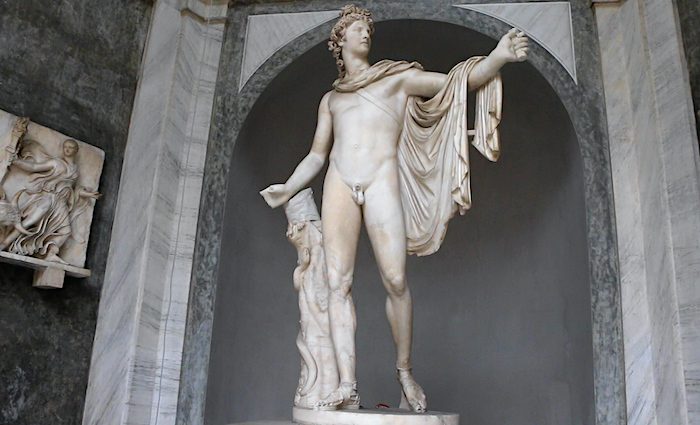
The Apollo Belvedere, a paragon of classical beauty and divine grace, is a renowned marble sculpture representing Apollo, the Greek god of the sun, music, and poetry. Crafted during the 2nd century CE in the Hellenistic period, this marble marvel is a Roman copy of a lost ancient Greek bronze original.
The sculpture embodies an epitome of youthful, godlike perfection, depicted in a dynamic contrapposto stance—a hallmark of classical sculpture. Apollo stands with an air of ethereal serenity, his muscular form and flowing drapery conveying a sense of effortless elegance and divine power.
The Apollo Belvedere has profoundly influenced Western art and has been a subject of admiration, emulation, and study for centuries. Its timeless beauty and idealized representation have inspired artists, sculptors, and art enthusiasts throughout history. Today, this masterpiece continues to captivate audiences, inviting contemplation on the enduring allure of ancient aesthetics and the embodiment of divine ideals in marble.
Michelangelo's Moses
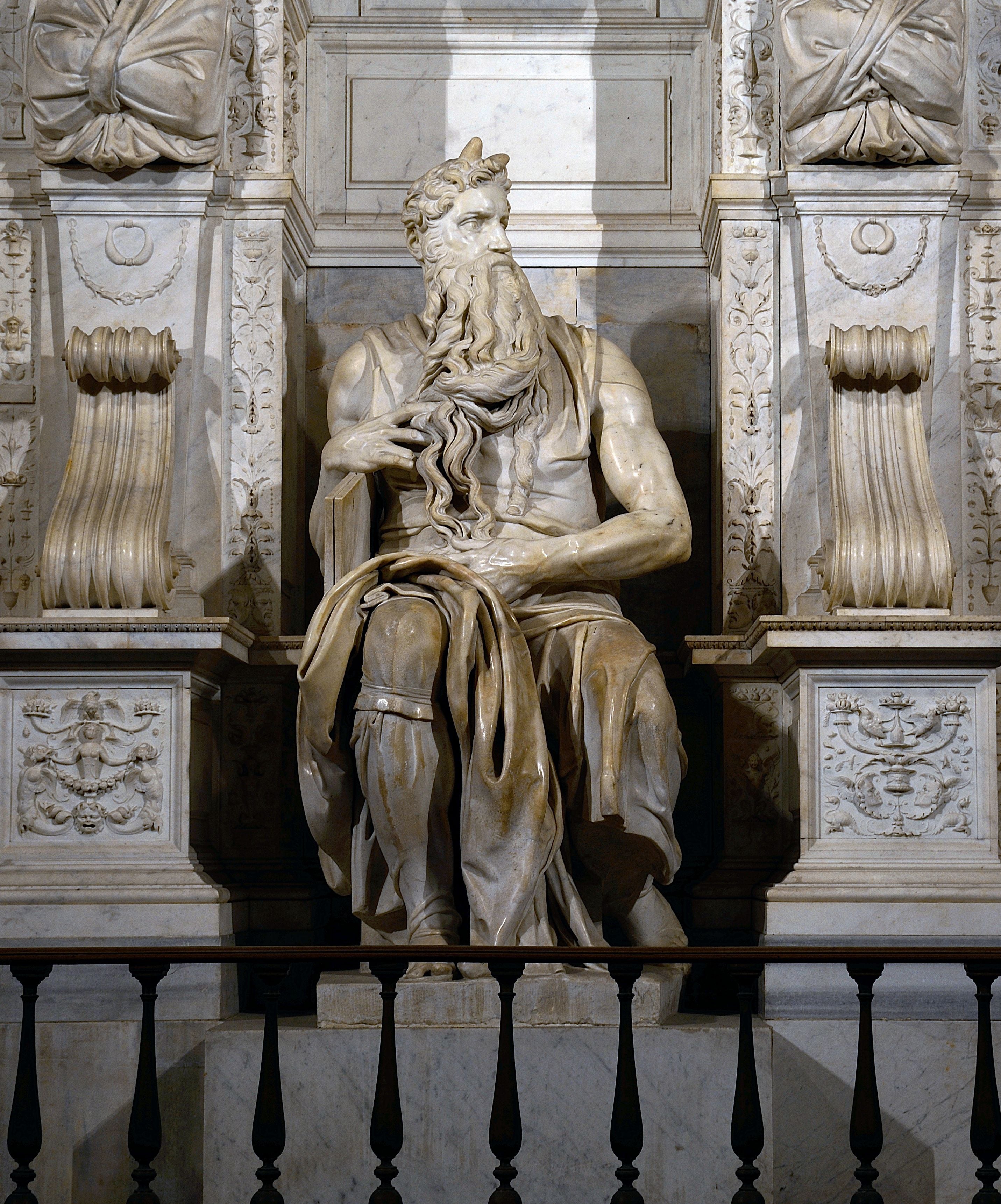
Michelangelo's Moses, a masterpiece of Renaissance sculpture, brings the biblical figure to life with unparalleled artistry and emotion. Crafted from Carrara marble between 1513 and 1515, Moses is a central figure within the tomb of Pope Julius II in Rome's San Pietro in Vin coli church.
The sculpture portrays Moses as a contemplative and authoritative figure, seated in a commanding pose with flowing beard and horns, inspired by the biblical passage in Exodus describing Moses' radiant countenance. The meticulous detailing of muscles, veins, and facial expressions showcases Michelangelo's extraordinary ability to animate stone and capture human emotion.
Moses' intense gaze and powerful presence embody both the wrath of the lawgiver and his deep connection with the divine. This monumental work epitomizes Michelangelo's genius, illustrating his mastery over the marble medium and his ability to transcend it to create a profoundly spiritual and emotional representation. The statue remains an awe-inspiring testament to Renaissance art and the enduring legacy of one of history's greatest artists.
The archetypal ancient Greek male form: Laocoön and his sons
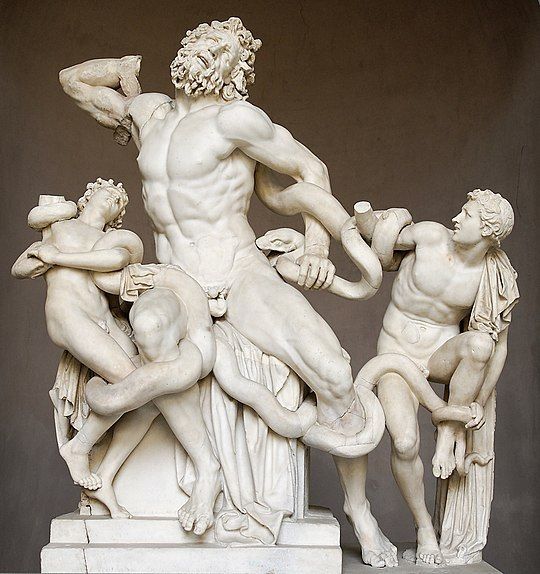
The Laocoön and His Sons, a quintessential representation of the ancient Greek male form, stands as a paragon of Hellenistic sculpture and the epitome of human suffering and strength. Carved in marble during the 1st century BCE, this renowned masterpiece tells the tragic tale from Greek mythology.
The sculpture captures Laocoön, a Trojan priest, and his sons in the throes of anguish as they are entangled by sea serpents, sent by the gods to punish them. The chiseled musculature and anatomical precision showcase the idealized male physique, embodying strength and heroism even in the face of impending doom.
The Laocoön and His Sons remains a powerful study of the human form, an evocative portrayal of agony, and a symbol of resistance against fate. Its influence reverberates through art and continues to inspire artists, scholars, and admirers, illustrating the enduring impact of ancient Greek aesthetics and the portrayal of human emotion through the medium of marble.
Venus de’ Medici
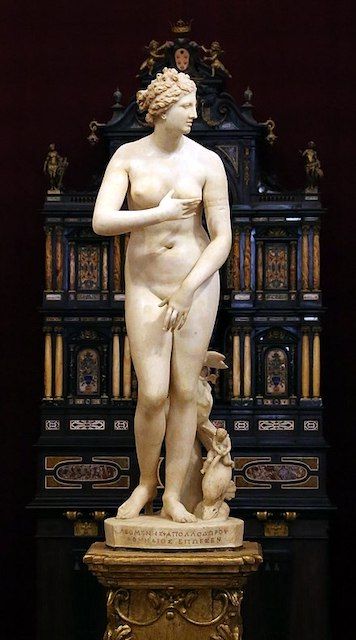
The Venus de' Medici, an iconic marble sculpture dating back to ancient Greece, embodies the epitome of feminine beauty and grace. Created during the Hellenistic period, around the 1st century BCE, this sculpture portrays the goddess Aphrodite, known as Venus in Roman mythology.
The Venus de' Medici stands in a sensuous pose, captured in a moment of timeless elegance and modesty. The sculpture's proportions and delicate features are meticulously sculpted, emphasizing the idealized feminine form. The flowing drapery adds a touch of realism and ethereal charm, enhancing the illusion of movement and life.
Originally unearthed in Rome, the sculpture later became part of the Medici collection in Florence, Italy, giving it its name. The Venus de' Medici has had a profound influence on Western art and has inspired countless artists, serving as a paragon of classical beauty and femininity, a testament to the enduring fascination with the representation of the divine and the aesthetic allure of ancient Greek artistry.
Venus de Milo
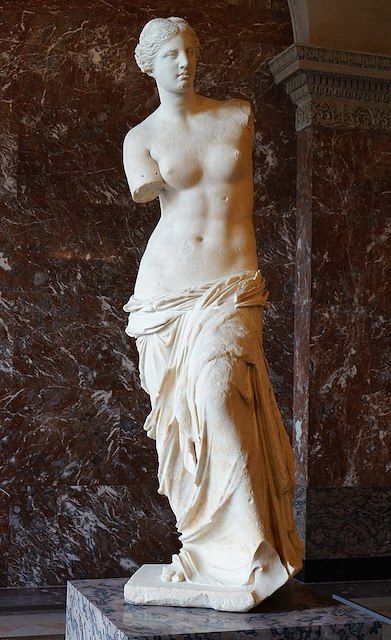
The Venus de Milo, an ancient Greek marble sculpture, stands as a symbol of timeless beauty and classical aesthetics. Created during the Hellenistic period, around 130-100 BCE, it is believed to depict Aphrodite, the Greek goddess of love and beauty, known as Venus in Roman mythology.
Discovered in 1820 on the island of Milos (Milo in Greek), the sculpture is celebrated for its exquisite craftsmanship and the missing arms, adding an air of mystery and intrigue to its narrative. The Venus de Milo stands in a captivating contrapposto pose, with delicate drapery cascading around her hips and legs, emphasizing her idealized form.
The sculpture has inspired generations of artists, critics, and art enthusiasts, remaining an iconic representation of feminine beauty and grace. Its gracefulness, poise, and ethereal charm continue to captivate audiences, solidifying its place as a timeless masterpiece and a testament to the enduring appeal of ancient Greek art.
Pierre Legros' Cherubs Playing with a Lyre and Jean-Baptiste Tubby's Cherubs Playing with a Swan
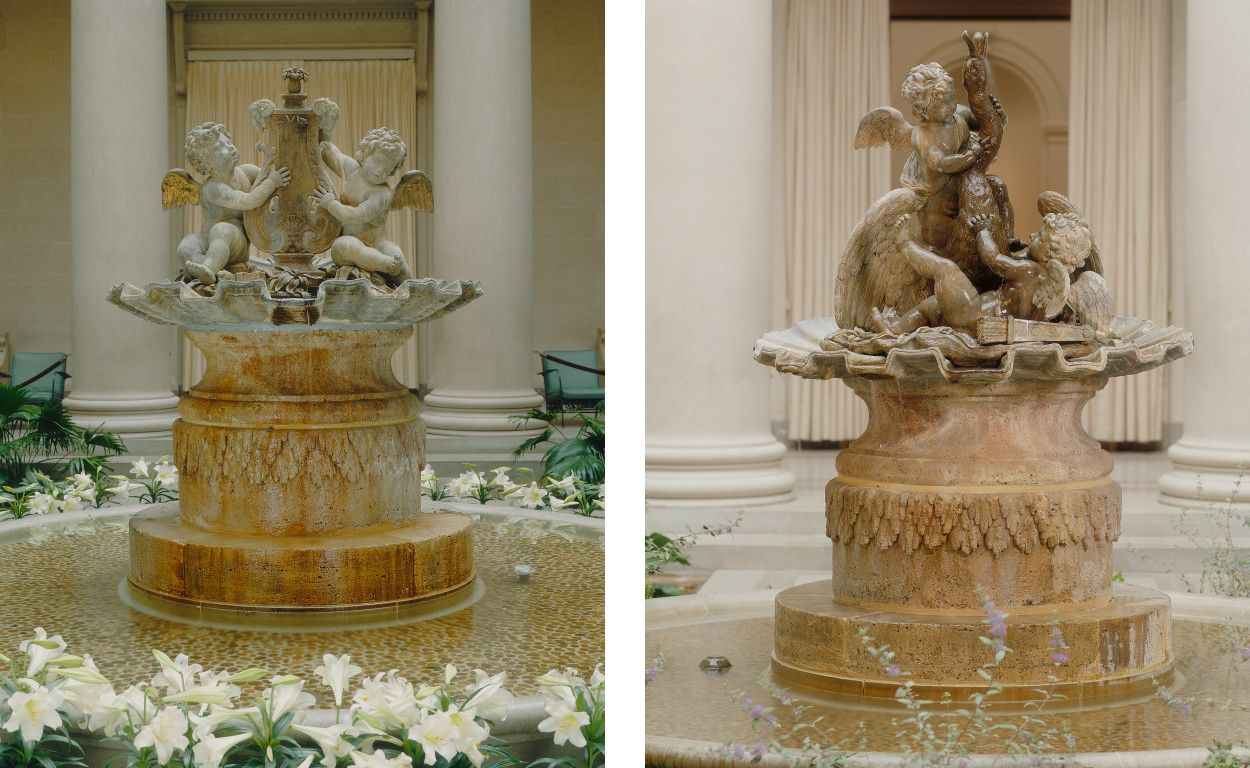
Pierre Legros' "Cherubs Playing with a Lyre" and Jean-Baptiste Tubby's "Cherubs Playing with a Swan" are two exquisite marble sculptures that grace the east court, showcasing the epitome of Baroque artistry and the celebration of innocence and playfulness.
In Legros' creation, the cherubs are depicted joyfully engaging with a lyre, a symbol of music and harmony. The intricate detailing of their cherubic features and the delicate rendering of the lyre emphasize the playful spirit and youthful exuberance that characterize Baroque art.
On the other hand, Tubby's sculpture portrays cherubs playfully interacting with a swan, a representation of purity and elegance. The intricate carving of feathers and the expressions of the cherubs reflect the Baroque penchant for capturing movement and emotion in stone.
Together, these sculptures embody the Baroque fascination with depicting lively and whimsical scenes, invoking a sense of delight and wonder in the observer. Their placement in the east court adds to the overall ambiance of beauty and artistic brilliance, inviting viewers to immerse themselves in the enchanting world of Baroque sculpture.
Sleeping Hermaphrodite On Bed
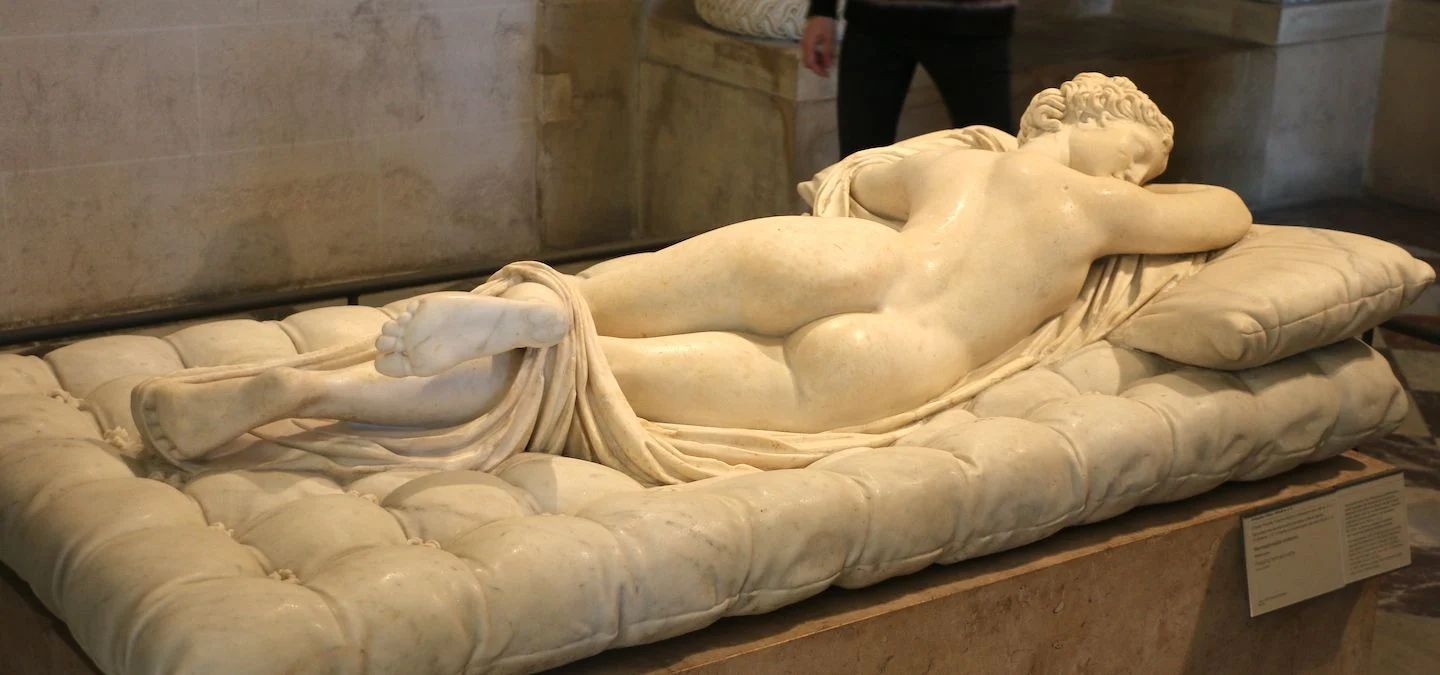
The Sleeping Hermaphrodite on Bed, an ancient marble sculpture, is a captivating embodiment of classical artistry and mythology. Originating from the 2nd century BCE, this sculpture depicts Hermaphroditus, the offspring of Hermes and Aphrodite, in a state of peaceful slumber.
The sculpture masterfully portrays Hermaphroditus, a being of both sexes, with a level of delicacy and sensuality that reflects the grace and beauty of ancient Greek aesthetics. The artist adeptly captures the supple form and contours of the reclining figure, showcasing exquisite craftsmanship and attention to detail.
The Sleeping Hermaphrodite on Bed has endured centuries, attracting admirers and artists alike. Its representation of androgyny and the convergence of male and female attributes have intrigued and inspired interpretations across various artistic mediums. Today, this timeless sculpture stands as an enduring testament to the genius of ancient sculptors and the allure of ambiguity and elegance that defines classical art.
Antonio Canova- 1801/04- Perseu e a cabeça de Medusa
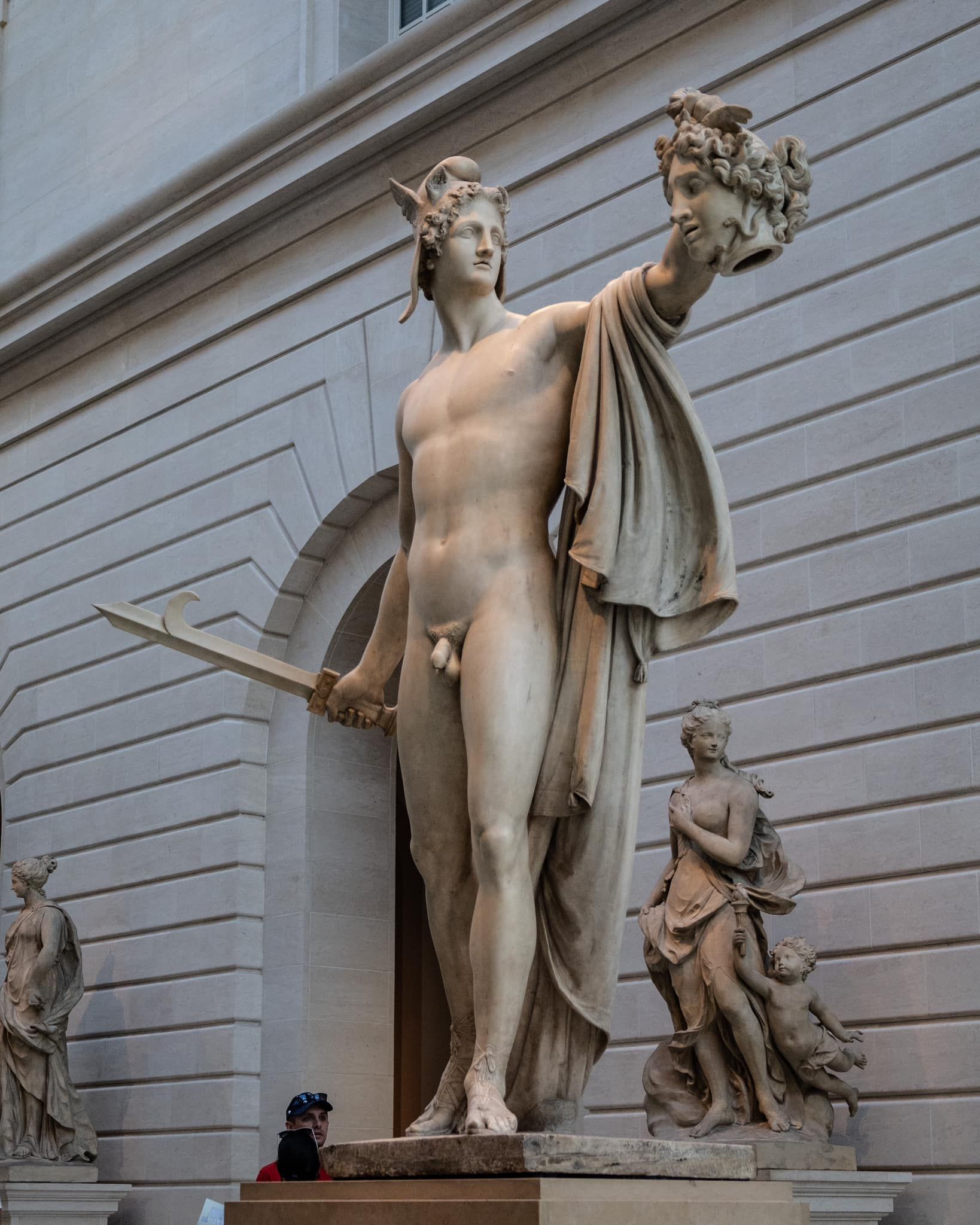
Antonio Canova's "Perseus with the Head of Medusa," executed between 1801 and 1804, is a neoclassical masterpiece that embodies the myth of Perseus, the legendary Greek hero. This marble sculpture captures the climactic moment when Perseus triumphs over the fearsome Gorgon, Medusa.
Canova's expert craftsmanship is evident in the dynamic composition, showcasing Perseus in a powerful stance, brandishing the severed head of Medusa. The meticulous attention to detail, from the intricate musculature to the flowing drapery, epitomizes the neoclassical style. Perseus' expression, a mix of determination and victory, is a testament to Canova's ability to convey emotion through stone.
The sculpture stands as a symbol of courage, heroism, and the triumph of good over evil, reflecting the neoclassical era's fascination with ancient Greek and Roman themes. "Perseus with the Head of Medusa" remains a celebrated artwork, admired for its technical brilliance and the enduring resonance of its narrative.
Rape of Proserpina
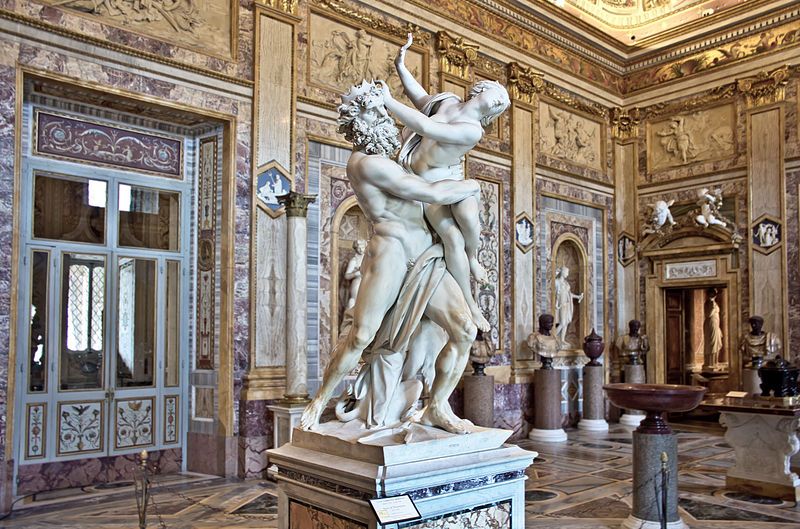
The "Rape of Proserpina" is a Baroque marble sculpture created by Gian Lorenzo Bernini in 1621-1622, portraying the mythological abduction of Proserpina by Pluto, the god of the Underworld. The sculpture mesmerizes with its exceptional artistic skill and emotional intensity.
Bernini's work is a marvel of motion and emotion, depicting Pluto's forceful grasp on the struggling Proserpina. The details, such as the flesh-like texture of Proserpina's skin and the intricate drapery, showcase Bernini's mastery in conveying lifelike realism in stone. The dynamic composition encapsulates the desperation and anguish of Proserpina, contrasting with the god's imposing strength.
The "Rape of Proserpina" remains a vivid representation of the Baroque era's dramatic and theatrical approach to art. It invites viewers to engage with the complex narrative and appreciate the genius of Bernini, leaving a lasting impact on the world of sculpture and continuing to captivate audiences with its emotional power and artistic grandeur.
Antonio Frilli (1880-1920) | Figurative sculptor

Antonio Frilli (1880-1920) was a renowned Italian figurative sculptor whose artistic contributions left an indelible mark on the late 19th and early 20th centuries. He was celebrated for his exceptional ability to breathe life into marble, crafting intricate, expressive sculptures that showcased a deep understanding of human anatomy and emotion.
Frilli's work often revolved around mythological, historical, and religious themes, illustrating a profound reverence for classical aesthetics and forms. He possessed a rare talent for capturing the delicate nuances of facial expressions, gestures, and postures, allowing his sculptures to convey deep emotions and tell compelling stories.
During his brief yet impactful career, Antonio Frilli gained recognition and admiration from art enthusiasts, collectors, and fellow artists alike. His legacy lives on through his timeless sculptures, which continue to be appreciated for their exquisite craftsmanship, artistic vision, and the enduring beauty they bring to the world of figurative sculpture.
Sileno con Dioniso Bambino
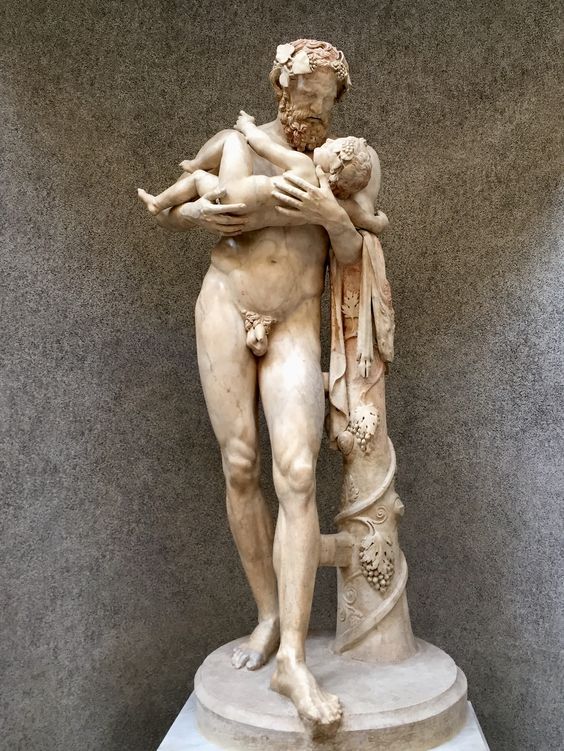
"Sileno con Dioniso Bambino" (Silenus with Baby Dionysus) is a captivating sculpture created by Italian artist Antonio Frilli. This masterpiece reflects the neo-Renaissance style, prevalent during the late 19th and early 20th centuries.
In this sculpture, Frilli skillfully portrays Silenus, a companion and tutor to Dionysus, the Greek god of wine and revelry. Silenus cradles Baby Dionysus in his arms, encapsulating the tender and intimate bond between the mentor and his youthful charge. The intricately carved details bring the characters to life, showcasing the artist's mastery over marble.
Frilli's "Sileno con Dioniso Bambino" is an exquisite representation of classical mythology, emphasizing the theme of mentorship and the nurturing influence of wisdom on youthful exuberance. The sculpture encapsulates the enduring artistic legacy of Antonio Frilli, capturing the essence of ancient tales and enriching the world of art with its timeless beauty and symbolism.
Roma, Galata suicida
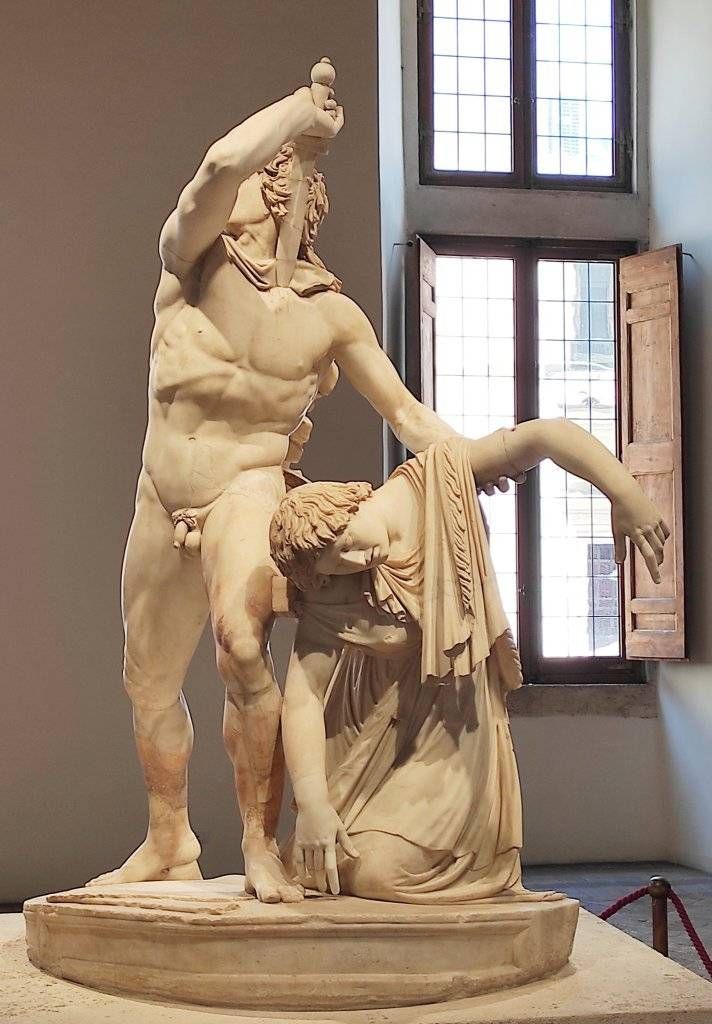
"Roma, Galata suicida" is a striking sculpture portraying the city of Rome and a Gallic warrior in the act of suicide. The sculpture, also known as the "Dying Galatian" or "The Ludovisi Gaul," is a powerful representation of Hellenistic art, displaying intense emotion and raw humanity.
The Gallic warrior, defeated and wounded, prepares to end his own life to escape the ignominy of defeat. The intricate detailing in the musculature, posture, and expression captures the agony and desperation of the moment. Created during the 2nd century BCE, this masterpiece stands as a reminder of the tumultuous history of the Roman Republic and its encounters with formidable adversaries.
The "Roma, Galata suicida" sculpture has a profound impact, showcasing the aesthetic sophistication and emotional depth of Hellenistic art. It remains a poignant portrayal of valor, defeat, and the complex interplay of cultures during a tumultuous period in ancient history.
Bacchus with Satyr’ Sculpture
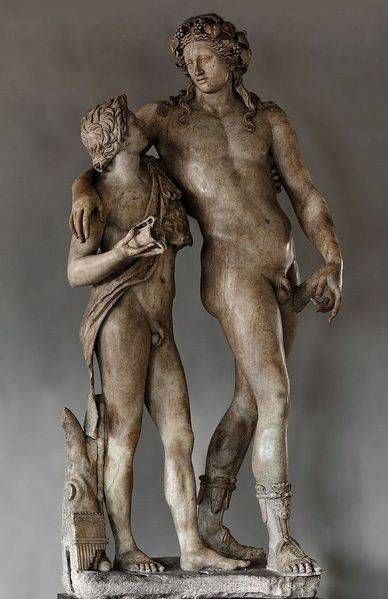
"Bacchus with Satyr," a captivating marble sculpture, epitomizes the fusion of Greek mythology and artistry. Crafted in the 17th century by the renowned Italian sculptor Gian Lorenzo Bernini, this masterpiece portrays Bacchus, the Roman god of wine and revelry, alongside a playful satyr.
The sculpture breathes life into the narrative, illustrating Bacchus holding a goblet of wine, an emblem of his domain, while the satyr engages in a playful interaction. Bernini's meticulous attention to detail, from the flowing hair to the delicate features, showcases his exceptional skill in conveying emotion and movement through marble.
"Bacchus with Satyr" exemplifies the Baroque style, renowned for its dynamism and theatricality. The playful, almost flirtatious dynamic between the figures underscores the celebration of joy and indulgence associated with Bacchus, creating a delightful and engaging scene.
As an iconic representation of classical mythology and artistic brilliance, "Bacchus with Satyr" remains a cherished artwork, inviting admirers to immerse themselves in the vivacious world of Roman gods and the exuberance of the Baroque era.
1 comment
Wonderfull and attractive ancient art sculptures. Natural beauty of west.